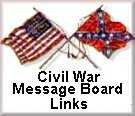The American Civil War. The War Between The States. The War of the Rebellion. The War of Northern Aggression. The conflict that raged between 1861 and 1865 has come to be known by many different titles since the war’s end.
The name that has come to mean more to me since my younger days would be “The Brothers War.” There were countless examples of families torn apart by politics, or by a string of circumstances which placed siblings on opposite sides. Such circumstances led to two of my ancestors finding themselves in rival armies.
These two brothers, William Henry and Cummings Marshall, were born in Lumpkin County, Georgia, in the 1840’s. Their father, Abel Cummings Marshall, the brother of my great-great grandfather, had come from the forests and rock-strewn farms of northern New Hampshire to the gold fields near Dahlonega in search of his fortune. Shortly thereafter, he married Lucinda Hawkins of South Carolina. Over the next few years Lucinda gave birth to four children – William Henry, Cummings, Melinda, and Martha. Abel disappeared from records sometime in the 1850’s – my suspicion is that he followed other miners to California seeking gold, though I have yet to substantiate that. In any event, Lucinda was left to raise her children by herself (the 1860 census lists her as head of household). Cummings also left the family – he journeyed to New Hampshire to live with relatives there. (More on Cummings later)
In early 1861, twenty-one year-old William Henry Marshall enlisted in the Dahlonega Volunteers, and soon was parading on the old Mustering Grounds in Dahlonega, from which North Georgia volunteers had assembled for earlier conflicts such as the Texas War for Independence and the Mexican War. Called by Governor Joseph E. Brown in late March to proceed to Macon, the Volunteers were designated Company “H” of the First Georgia Volunteer Infantry. William Henry was engaged in all the First Georgia actions, including Laurel Hill, Cheat Mountain, Greenbrier River and the Bath-Romney Campaign, and was among those Georgians lost in the Allegheny Mountains after being cut off from the Army of the Northwest at Kalers Ford. After mustering out with the regiment in Augusta on March 10, 1862, William Henry reenlisted on May 6 in the Fulton Dragoons, which became Company “B” of Cobb’s Legion of Cavalry (later Company “G”). Muster rolls for November and December, 1863, and March and April 1, 1864, list him as absent at recruiting camp. He was received at General Hospital No. 9 in Richmond on October 19, with the disposition written as “Duty”. His last military entry shows him admitted to C.S.A. Hospital No. 3 at Greensboro, North Carolina in April of 1865.
In my next post, I’ll talk about William Henry’s brother, Cummings, who was in the Union army, and what happened to the brothers and their family after the war.
Subscribe to:
Post Comments (Atom)
.jpg)










No comments:
Post a Comment